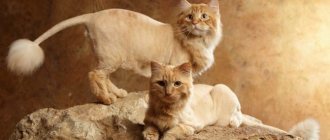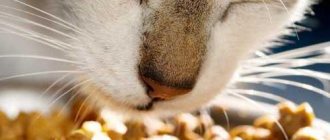When and how did a person domesticate a cat?
The history of the rapprochement between cats and people is quite complicated. Researchers are still debating who tamed whom first: man's cat, or man's cat?
According to one version, cats were domesticated thanks to the initiative of the inhabitants of the Middle East. Ancient people only learned to cultivate the land, as a result of which it became necessary to protect the crops from hungry rodents. To ensure the safety of food supplies, they cunningly lured the cat and adapted it to their needs.
Another version looks no less plausible. It is likely that ancient cats were able to “domesticate” on their own. Observant animals quickly realized that people had a lot of food supplies, near which rodents lived. They took the initiative and began to stay closer to human habitations. Thus, the animals provided themselves with a constant source of food.
Scientific research
The process of domestication may have begun about 10,000 years ago, when humans settled in the Fertile Crescent, an arched region that includes the eastern shore of the Mediterranean Sea and the land around the Tigris and Euphrates rivers. People stored grain there - the main source of food, which is also loved by rodents, which in turn attracted wild cats. Over time, these wild cats adapted to this artificial environment and got used to people and completely stopped being afraid of them.
Cats were clearly tame around 3,500 years ago in Egypt, where paintings often placed them under chairs. This shows that by that time “the cat had reached the house.” At that time, this animal was a symbol of fertility, since on the frescoes of the ancient Egyptians the cat was depicted under a woman’s chair when the family dreamed of replenishment.
History of cat domestication
The exact date of this historical event is not known, but scientists agree that this process began about 10,000 years ago. Evidence of this has been found in different places on the planet. So, during excavations in Egypt, archaeologists discovered the remains of cats next to human fragments. The human and animal skeletons were only 40 cm apart. Joint burials indicate that cats were already domesticated at that time.
The process of domesticating cats began approximately 10,000 years ago. Since then they have been inseparable from people.
Cats are also present in the wall paintings of ancient Egyptian buildings. The oldest art among those discovered is at least 4,500 years old.
On the territory of ancient Turkey, ancient figurines were found depicting a woman with a cat. Their approximate age is 8000 years. Similar artifacts have been discovered in other countries.
During excavations on the Greek island of Crete, experts also found joint burials of humans and cats about 9,500 years old. Based on these artifacts, scientists concluded that cats appeared in Cyprus earlier than in Egypt. They probably came to ancient Egypt along with settlers from the Middle East.
If at first individual civilizations were involved in the domestication of cats, later this process became widespread. Active domestication of furry hunters was noted as early as 1000 BC. during the rise of civilizations. Residents of Europe accepted tailed pets into their farms and entrusted them with the important mission of preserving the harvest. It was during that significant period that cats finally formed their behavior and began to be universally considered pets.
The cat is an excellent companion. She easily gets along in the home of large families with children and becomes a true friend to lonely old people. Although cats often have capricious and unpredictable personalities, they are loved for their striking appearance, grace and playfulness. It is not for nothing that this furry pet is one of the three most popular animals to keep at home.
Agricultural development
In ancient times, when the main type of human activity was hunting and gathering, the question of domesticating cats was not even raised. However, with the development of agriculture, people finally paid attention to wild representatives of the cat family. They showed excellent skills in catching small rodents, which the first peasants needed. After all, from year to year, crops and food were under constant threat because of grain lovers - rats and mice.
Historians suggest that the domestication of cats occurred more than 10 thousand years ago. Thus, one of the burials, dating back to the 8th millennium BC, was discovered by archaeologists in Cyprus. In the grave next to the owner lay his pet, a cat. However, the most widespread domestication of cats, according to scientists, began in Ancient Egypt.
The cat received a high, divine status in Egypt. The one who killed the cat, according to the Egyptian laws of those years, was obliged to suffer severe punishment, including the death penalty. If the pet simply died of old age, its owner shaved off his eyebrows as a sign of mourning.
Origin of cats
The history of the appearance of the cat is shrouded in mysterious secrets. There are the most fantastic versions about the origin of this furry animal.
Religious version
One of the most popular explanations involves Noah's Ark. Everyone knows that according to legend, during the Great Flood, all living beings of the ancient world found salvation on this giant ship. The Ark sailed for a long time, so a lot of fetid excrement accumulated on board. Strong odors interfered with normal life on the ship. At the same time, the rodents multiplied with such force that they destroyed all food supplies. The inhabitants of the ark were threatened with terrible death from starvation.
Then, according to legend, God decided to help again. On the advice of the Almighty, Noah stroked the elephant's trunk. At the same moment, a pig appeared from the animal’s nose and began to destroy all waste products. Then God told Noah to stroke the lion's nose, after which a cat jumped out. She destroyed all rodents and thereby saved all animals and people from starvation.
Mythological version
Ardent adherents of the legend about the unearthly origin of cats claim that these furry pets flew to our planet from outer space. According to this theory, the first alien cats settled in ancient Egypt. At the same time, the animals were bald and even contacted ancient people, transmitting information to them by the power of thought.
One day, a bald cat met a shaggy steppe cat. She fell in love with him and decided to stay on Earth. The couple multiplied and multiplied, leaving numerous furry offspring, the representatives of which are the ancestors of modern domestic cats.
The theory of the alien appearance of cats is confirmed by the discovery of astronauts from the United States. During the moon landing, they discovered strange small artifacts and brought them with them. Laboratory analysis concluded that it was cat feces.
Scientific version
The official scientific version about the evolutionary origin of cats from ancient creodonts looks more plausible. These dangerous predators inhabited the Earth approximately 50 million years ago and kept weaker animals at bay. In size, the creodont was slightly larger than the modern tiger.
There is no direct evidence of this theory, but many facts indirectly indicate that the origin of the ancestors of the modern cat occurred during the migration of mammals.
According to other assumptions of zoologists, the cat's ancestors were proaurus. This animal lived about 20 million years ago. He weighed about 9 kg and climbed trees perfectly thanks to his tenacious legs. Outwardly, Proaiurus resembled a marten. He hunted deftly and could fend for himself.
Within the framework of this scientific hypothesis, experts believe that two branches of animals evolved from Proaurus. These are the ancient saber-toothed cats and the modern cat genus. As part of the evolutionary process, saber-toothed cats became extinct 10,000 years ago, and the ancestors of domestic pets continued their development.
Cats are popular in most countries of the world and are very close to humans. Many people proudly call themselves cat people. However, despite their taming and domestication, cats still consider themselves unconquered creatures and prefer to walk on their own. This is evidenced by their freedom-loving disposition, as well as their independent character. Therefore, the life of cats next to humans can be considered a real gift.
Why not a dog?
According to historians, the cat was domesticated much later than other animals: geese, buffalos or even dogs. Despite the fact that the latter are also quite good rodent hunters, man still chose representatives of the cat family. Some researchers associate this circumstance with the pretty appearance of cats, others with their cleanliness and comparative unpretentiousness.
The fact is that domesticated dogs had to be fed special food. While domesticated cats could eat what they caught, that is, rats and mice. Of course, for good work they received treats and affection, but the basis of their diet was still rodents.
Inhabitants of the Moon or distant stars
Plotinus (a Neoplatonist philosopher) argued that cats came to us from the Moon. They are well oriented in the dark, active at night and their behavior is directly influenced by the phases of the moon.
Augustine the Blessed believed that cats came to us from those distant stars where the human soul goes after death. God showed them the way there and back and gave them the ability to interact with spirits. Have you noticed how cats often and for a long time look into emptiness?
A mysterious origin is attributed to cats, among other things, for their unusual character. No matter where these animals come from, they will always remain our favorite pets. When you feed a stray cat on the street, think about it: what if you are paying tribute to an alien creature?
The appearance of cats in Rus'
Excavations carried out in Russia and the former Soviet Union have shown that cats appeared on our lands in the seventh century. But the first descriptions of these animals are in documents dating back to the eleventh century. It is assumed that foreign sailors brought strange animals to Russia and sold them for huge sums of money. People liked this creature, because its eyes glow in the dark, and from any height it falls on all four paws, and even purrs! Over time, the cats began to breed and multiply, and now in the peasant huts the beast caught mice and rats, protecting the owner's supplies. There is a legend that Peter the Great himself adored these creatures and, seeing how another cook was chasing a fluffy one, declared cats to be inviolable creatures. You may ask, why does a chef need a cat? This animal simply brought him a dead rat as proof of its work and irreplaceability and placed it on the cutting table. That's all. But since then no one could offend the tailed one in Rus'.
Siamese cat in America
Since 1890, Siamese cats have become widely known even outside their homeland, including America and Australia. The very first Siamese appeared in the White House in 1878. Their owner was Mrs. B. Hayes. Externally, such animals were noticeably different from modern types of Siamese - they had a shorter and uneven profile, as well as a rounded and rather massive head.
The first known color of the purebred Siamese cat is seal point, represented by dark brown or blackish markings on the beige coat of the body. It is this color that is still considered the so-called “royal” color.
In the thirties, the blue point color was recognized in America, and a little later the popular colors lilac point and chocolate appeared in the country. Tabby point was only recognized in the sixties. In the fifties, felinologists adopted a new standard for breed Siamese, according to which a purebred animal must have a narrow and wedge-shaped head, a long body, high legs and large, wide-set ears.
Spots and stripes on fur
Wild and domestic cats had no significant differences in their genetic structure, and one of the few traits available to differentiate them was their coat markings.
The study sheds light on the late appearance of spotted or tabby coats, which began appearing in domestic solid-colored cats in the Middle Ages. The gene for the striped coat dates back to the Ottoman Empire in Southwest Asia and later became common in Europe and Africa.
However, it was not until the 18th century that markings became common enough to be associated with domestic cats, and in the 19th century, cat fanciers began selecting cats with special traits to create unusual breeds.











